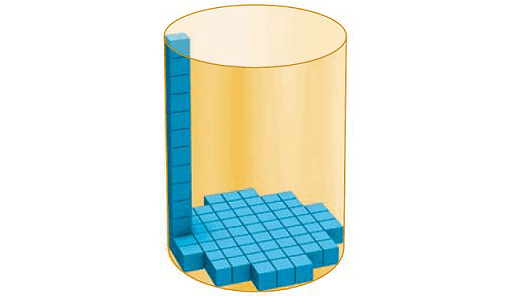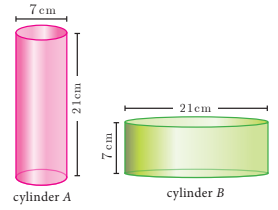EXAMPLES ON VOLUME OF CYLINDER
Subscribe to our ▶️ YouTube channel 🔴 for the latest videos, updates, and tips.
We can find the volume V of both a prism and a cylinder by multiplying the height by the area of the base.
Let the area of the base of a cylinder be B and the height of the cylinder be h. Write a formula for the cylinder’s volume V.
V = Bh
The base of a cylinder is a circle, so for a cylinder,
B = πr2
Then, we have
V = πr2h cubic units

Example 1 :
Find the volume of a solid cylinder whose radius is 14 cm and height is 30 cm.
Solution :
We need to find the volume of the solid cylinder.
Radius of the cylinder = 14 cm
Height of the cylinder = 30 cm
Volume of the right circular cylinder = πr2h
= (22/7) · (14)2 · 30
= (22/7) · 14 · 14 · 30
= 18480 cubic.cm
Volume of the cylinder = 18480 cubic.cm
Example 2 :
A patient in a hospital is given soup daily in a cylindrical bowl of diameter 7 cm. If the bowl is filled with soup to a height of 4 cm, then find the quantity of soup to be prepared daily in the hospital to serve 250 patients?
Solution :
Radius of the cylinder = 7/2 cm
Height of the cylinder = 4 cm
To find quantity of soup in one bowl, we have to find the quantity of each bowl.
Volume of the right circular cylinder = πr2h
= (22/7) · (7/2)2 · 4
= (22/7) · (7/2) · (7/2) · 4
= 154 cm3
Volume of soup in one cylindrical bowl = 154 cm3
Volume of soup in 250 cylindrical bowl = 250 · 154
= 38500 cm3
1000 cm3 = 1 L
Therefore required quantity of soup = 38500/1000
= 38.5 L
Required quantity of soup for 25 patients = 38.5 L
Example 3 :
The sum of the base radius and the height of a solid cylinder is 37 cm. If the total surface area of the cylinder is 1628 sq.cm, then find the volume of the cylinder.
Solution :
Let r and h are the radius and height of the cylinder respectively
Sum of radius and height = 37
r + h = 37 cm
Total surface area of cylinder = 1628 sq.cm
2πr(h + r) = 1628
2πr(37) = 1628
2πr = 1628/37
2 · (22/7) · r = 44
r = 44 · (1/2) · (7/22)
r = 7
7 + h = 37
h = 30 cm
Volume of the right circular cylinder = πr2h
= (22/7) ·72·30
= (22) x (7) x (30)
= 4620 cm3
Volume of cylinder = 4620 cm3
Example 4 :
The volume of a cylindrical water tank is 1.078 × 106 litres. If the diameter of the tank is 7 m, find its height.
Solution :
Volume of cylinder = 1.078 × 106
1000 liter = 1 m3
Diameter = 7 m
= 1.078 × 103 x 103
= 1078
radius = 3.5 m
πr2h = 1078
3.14 x 3.52 x h = 1078
h = 1078 / (3.14 x 3.52)
= 1078 / (3.14 x 12.25)
h = 28.02
Example 5 :
Find the volume of the iron used to make a hollow cylinder of height 9 cm and whose internal and external radii are 21 cm and 28 cm respectively.
Solution :
Height (h) = 9 cm
External radius (R) = 28 cm
Internal radius (r) = 21 cm
Volume = πh(R2 - r2)
= 3.14 x 9 x (282 - 212)
= 3.14 x 9 x (784 - 441)
= 3.14 x 9 x 343
= 9693.18 cm3
Example 6 :
For the cylinders A and B

(i) find out the cylinder whose volume is greater.
(ii) verify whether the cylinder with greater volume has greater total surface area.
(iii) find the ratios of the volumes of the cylinders A and B.
Solution :
i)
Volume of cylinder A = πr2h
Radius = 7/2 ==> 3.5 cm, height (h) = 21 cm
= 3.14 x 3.52 x 21
= 807.765 cm3
Volume of cylinder B = πr2h
Radius = 21/2 ==> 10.5 cm, height (h) = 7 cm
= 3.14 x 10.52 x 7
= 2423.295 cm3
Cylinder B is greater.
ii)
Total surface area of cylinder A = 2πr(h + r)
= 2 x 3.14 x 3.5 (21 + 3.5)
= 21.98(24.5)
= 538.51 cm2
Approximately the surface area of cylinder A is 539 cm2
Total surface area of cylinder B = 2πr(h + r)
= 2 x 3.14 x 10.5 (7 + 10.5)
= 65.94(17.5)
= 1153.95 cm2
Cylinder B has greater volume and greater surface area.
iii) Volume of cylinder A / Volume of cylinder B
= 808/2423
= 1/3
So, the required ratio is 1 : 3.
Example 7 :
A 14 m deep well with inner diameter 10 m is dug and the earth taken out is evenly spread all around the well to form an embankment of width 5 m. Find the height of the embankment.
Solution :
height = 14 m
External radius (R) = ?
Inner radius (r) = 10/2 ==> 5 m
Width = 5 m
Width = R - r
5 = R - 5
R = 10 m
Volume of earth in the enbankment = Volume of the well
πh(R2 - r2) = πr2h
H x (102 - 52) = 52x14
H = (25 x 14)/(100 - 25)
= 350/75
H = 4.67 m
Subscribe to our ▶️ YouTube channel 🔴 for the latest videos, updates, and tips.
Kindly mail your feedback to v4formath@gmail.com
We always appreciate your feedback.
About Us | Contact Us | Privacy Policy
©All rights reserved. onlinemath4all.com

Recent Articles
-
US Common Core K-12 Curriculum Algebra Solving Systems of Equations
Jan 01, 26 04:51 AM
US Common Core K-12 Curriculum - Algebra : Solving Systems of Linear Equations -
Solving the HARDEST SAT Math Questions ONLY using Desmos
Dec 31, 25 05:53 AM
Solving the HARDEST SAT Math Questions ONLY using Desmos -
Times Table Shortcuts
Dec 30, 25 07:14 PM
Times Table Shortcuts - Concept - Examples
